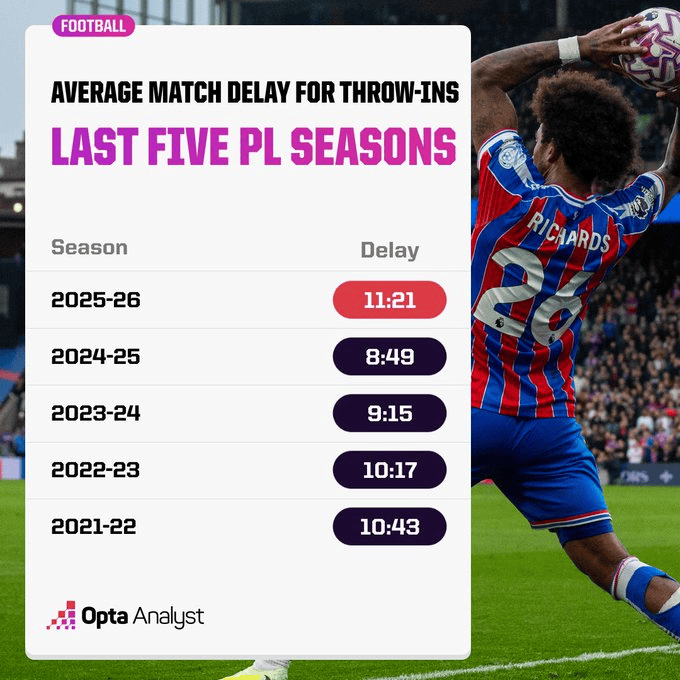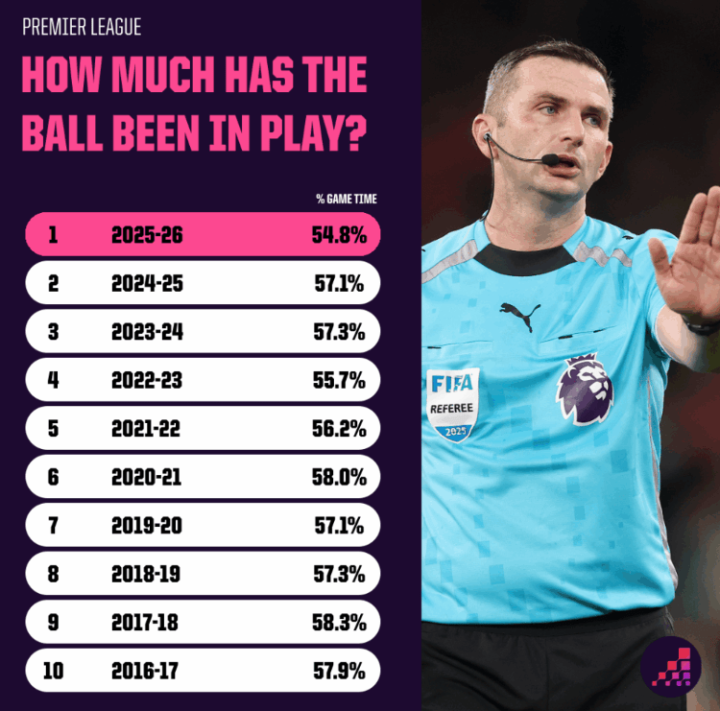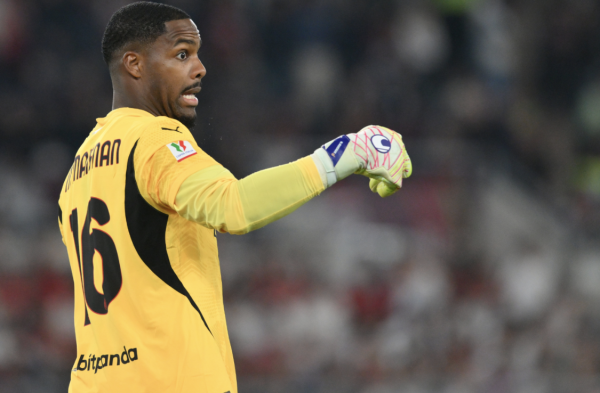HOME > Football
Premier League throw-in time increased significantly this season; net game time lowest in 10 years
12:18am, 30 October 2025【Football】

Hupu News on October 29th: Throw-in tactics have become a hot topic in the Premier League this season. Data website Opta wrote an article analyzing data related to foul balls and game time.
According to statistics from Opta (see header picture), the average waiting time for a throw-in in the Premier League this season is as high as 11 minutes and 21 seconds per game, which is the highest in recent seasons, and the average per game is nearly 2 and a half minutes more than last season - which means a large amount of net time is lost in the game.
At the same time, Opta also conducted other statistics-the proportion of net playing time in the game and the proportion of set-piece goals.
This season the Premier League averages only 54.8% of net game time per game, which is the lowest in the past 10 seasons and a full 2.5% lower than last season;
The proportion of set-piece goals in the Premier League this season has reached an astonishing 30%. In the history of the Premier League, it was only higher in the 2009-10 season.
At the same time, the number of goals per game in the Premier League is also declining.

The text of Opta analysis, and more specific data
Unless you have been completely isolated from the world during this period, you have probably noticed that set pieces play an extremely important role in the Premier League this season.
Arsenal, who lead the standings, are one of the teams best at scoring from set pieces in the history of the Premier League. Judging from the data of the current season, they are likely to rush all the way to the championship while relying heavily on set pieces.
In fact, Arsenal has been playing like this for several years. It’s unclear whether they alone started the league-wide craze for set pieces, but what is certain is that they at least partially inspired other teams to imitate this style of play. The data this season is very amazing:
In the current season, set-piece goals account for 30.0% of all goals, which is the second-highest number in the history of the Premier League, second only to the 31.0% in the 2009-10 season.
In the past 14 seasons, there has never been a season where the proportion of set-piece goals has exceeded 26%.
Last season (2024-25 season), this proportion was only 22.0%.
Looking specifically at corner kicks, this growth trend is even more obvious - 19% of goals in the Premier League this season (45/241 in total) came from corner kicks, which is the highest proportion in the history of the Premier League.
Meanwhile, most teams are now taking every opportunity to throw long throw-ins directly into the penalty area - a tactic that has been almost extinct since the 1990s, especially among top teams.
There are an average of 4 long-distance throw-ins (more than 20 meters away) entering the penalty area per game this season, which is more than twice the number since records began in the 2014-15 season.
This high emphasis on set pieces is indeed surprising.
It is true that Arsenal has been working hard to develop the potential of set pieces, but last season's champion was Liverpool, and they did not put much emphasis on set pieces.
So, can Arsenal really make the entire Premier League pay attention to set-pieces as a team?
Maybe not exactly.
However, teams like Arsenal and Brentford - the latter of which has long attached great importance to set pieces - have indeed given people a renewed understanding that set pieces are a powerful tool for narrowing the gap between strength and weakness.
When the ball goes out of bounds and almost all 22 people on the field gather in a penalty area, the economic power gap that usually determines the Premier League pattern becomes less obvious.
For a team like Brentford, it is much easier to overwhelm Manchester City at set pieces than to play better than Manchester City in open games.
So, from this perspective, this season’s trend seems reasonable. All teams - especially the three promoted teams - are looking for an advantage with set pieces. And a more balanced, competitive Premier League (with Bournemouth and Sunderland both in the top four) doesn't seem like a bad thing, right?
No matter the reason, the rise of set-piece tactics does have its positive significance.
Many traditional British fans are very happy about this, believing that this proves that the ideas of old-school coaches such as Allardyce and Tony Pulis were correct.
But at the same time, opposition voices are growing.
Many fans who are accustomed to the high-tempo, high-tech games of the Premier League begin to feel that games that rely on set pieces are slow and boring.
The reason is: Teams now invest huge energy, resources and research into set pieces.
Now that you’ve hired a set-piece coach and spent countless hours practicing on the training field, there’s no need to rush the kick-off.
Rushing will only lead to a decrease in the quality of the cross and unprepared players, thus wasting offensive opportunities.
However, the result of this approach is that this season's "net game time" is less than any season in recent years. The ball was actually rolling on the court only 54.8% of the time during the game, which was the lowest since records began in the 2015-16 season.
Statistical Details
In this season’s Premier League games, the average actual time for the ball to roll on the field per game is 55 minutes and 15 seconds.
This is 1 minute and 44 seconds less than last season, and nearly 3 minutes less than the previous season.
In the past ten seasons, only two seasons have had less actual game time - those were the first two seasons when VAR was first introduced, when the referee's decision-making time was too long, resulting in serious game delays.
Although VAR is still a factor causing the game to slow down this season, the delay of set kicks is also one of the main reasons.
Officials have been working hard to shorten the length of VAR determinations. Today’s determination time has been significantly reduced compared to when VAR was first introduced.
In addition, the number of times the ball goes out of bounds has not actually increased - the average is 94.9 times per game, which is actually less than the average of the past ten years.
However, the time it took for the ball to return to the court was the longest in the decade..
On average, 45 minutes and 31 seconds of every Premier League game is spent waiting for the ball to be put back into play.
This is the first time this average has exceeded 45 minutes since statistics began in 2015-16, and is nearly two minutes more than any other season, and a full three minutes more than last season.
Overall, the average time for game interruptions has increased across the board.
The average duration of each interruption in Premier League matches this season is 28.8 seconds, the highest value on record.
Among them:
(1) Corner kicks take an average of 36.3 seconds to be retaken, which is the longest in history;
(2) Throw-ins take an average of 17.9 seconds, which is also the slowest in history.
These three types of dead balls (corner kicks, foul kicks, and goal kicks) are the most obvious part of the increase in delay time this season.
For example:
Each throw-in takes an average of 1.76 seconds longer this season than last season.
And there are more throw-ins this season - 38.1 times per game, an increase from 32.9 times last season.
Taken together, this means that in this season, each Premier League game will spend an average of 11 minutes and 21 seconds waiting for the throw-in to be re-taken, compared with only 8 minutes and 50 seconds last season.
In other words, in every game this season, fans spend more than two and a half minutes just watching players prepare for throw-ins.
Mini-game recommendations:Color Page ASMRRelated Posts
- Zhan Jun: Sobo should be the most stable core for the Red Army in the new season. The most important thing is to improve the defense.
- 0-1, the former Premier League champion lost to Millwall and suffered 2 consecutive defeats in the English Championship + dropped to 10th place
- One-day Premier League news: Manchester United is accelerating the sale of backup shooters, Slott has a new target to buy defenders
- 22 seats have been reserved for the World Cup: Cape Verde, a small country with a population of 540,000, has advanced! There are 3 seats left in the African region.
- Defeat! Ruben Neves: Jota’s jersey gives me extra strength and the victory is well deserved
- Damn laughing: 1-0 in 90 minutes, Guardiola excitedly kissed the fourth official, and Manchester City was beaten 3 minutes later
- Infantino: Serie A is the league in my life, I will always pay attention to A
- 2025.08.31 Paris Football Club VS Metz Event Recommendation Analysis
- Austrian roster: Alaba leads, Sabize, Lemel, Anau, and Dansor are selected
- Real Madrid double stars Mbappe and Vinicius are in a crisis of self-confidence
Hot Posts
- Zhan Jun: Sobo should be the most stable core for the Red Army in the new season. The most important thing is to improve the defense.
- 0-1, the former Premier League champion lost to Millwall and suffered 2 consecutive defeats in the English Championship + dropped to 10th place
- One-day Premier League news: Manchester United is accelerating the sale of backup shooters, Slott has a new target to buy defenders
- 22 seats have been reserved for the World Cup: Cape Verde, a small country with a population of 540,000, has advanced! There are 3 seats left in the African region.
Recommend

Chelsea talks about Meinion transfer, players look forward to going to the Blues to play the European Championship

Liverpool and Crystal Palace are in a stalemate, Rennes star becomes a potential replacement

Beijing Guoan official: Team goalkeeper Han Jiaqi returns to the training ground

3 years of long appointment + right to speak in the locker room! Real Madrid changes the sky! The 43-year-old young coach airborne, Mbappe becomes the winner

Director Dortmund talks about summer window: These transfer operations are not easy, we have to talk slowly if the Premier League is too rich

Summer window expenditure ranking: Liverpool is far ahead, pharmaceutical factories + 9 Premier League teams form the top ten

Cristiano Ronaldo fell in the Copa del Rey again! Three years without a championship and missed the championship 13 times

Walcott: The Gunners kicked Manchester City s starting lineup conservatively, making Eze s substitute have a key role